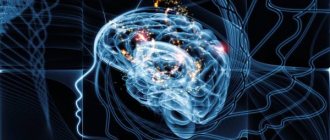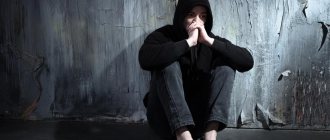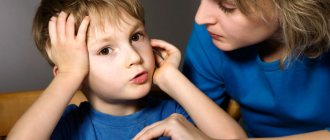Mental health is a very sensitive topic. Clinical manifestations of mental disorders depend on the age of the child and the influence of certain factors. Often, due to fear for future changes in their own life, parents do not want to notice some problems with the psyche of their child.
Many people are afraid to catch the sidelong glances of their neighbors, feel the pity of their friends, or change their usual life order. But the child has the right to qualified, timely assistance from a doctor, which will help alleviate his condition, and in the early stages of certain diseases, cure a mental disorder of one spectrum or another.
One of the complex mental illnesses is childhood psychosis. This disease is understood as an acute condition of a child or a teenager, which manifests itself in his incorrect perception of reality, his inability to distinguish the real from the imaginary, and his inability to really understand what is happening.
Features of childhood psychoses
Mental disorders and psychoses in children are not diagnosed as often as in adult men and women.
Mental disorders come in different types and forms, but no matter how the disorder manifests itself, no matter what symptoms the disease has, psychosis significantly complicates the life of the child and his parents, prevents him from thinking correctly, controlling actions, and building adequate parallels in relation to established social norms. Childhood psychotic disorders are characterized by:
- Delayed development of skills and intelligence. This feature appears in most cases. But there are diseases, for example, autism, during which the child has bright and advanced abilities in some area of activity. Experts say that in the early stages, mental disorders in children are difficult to distinguish from simple developmental delays, and therefore it is impossible to recognize a mental disorder.
- Problems with social adjustment.
- Violation of interpersonal relationships.
- A sublime and special attitude towards inanimate objects.
- Supporting monotony, not accepting changes in life.
Childhood psychosis has different forms and manifestations, which is why it is difficult to diagnose and treat.
Treatment of mental problems in children
Timely identification of behavioral disorders in children and the creation of a favorable psychological atmosphere makes it possible to correct mental disorders in most cases. Some situations require lifelong monitoring and medication. Sometimes it is possible to cope with the problem in a short time, sometimes it takes years to recover, with the support of the adults around the child.
Therapy depends on the diagnosis, age, causes of formation and type of manifestations of disorders; in each specific case, the treatment method is selected individually, even when the symptoms vary slightly. Therefore, when visiting a psychotherapist or psychologist, it is important to explain to the doctor the essence of the problem, to provide a complete description of the characteristics of the child’s behavior, based on the comparative characteristics before and after the changes.
The following are used in the treatment of children:
- In simple cases, psychotherapeutic methods are sufficient, when the doctor, in conversations with the child and parents, helps to find the cause of the problem, ways to solve it, and teaches how to control behavior.
- A set of psychotherapeutic measures and medication use indicate a more serious development of the pathology. For depressive states, aggressive behavior, and mood swings, sedatives, antidepressants, and antipsychotics are prescribed. Nootropics and psychoneuroregulators are used to treat developmental delays.
- In case of severe disorders, inpatient treatment is recommended, where the child receives the necessary therapy under the supervision of a doctor.
During and after treatment, it is necessary to create a favorable environment in the family, eliminate stress and the negative impact of the environment that influences behavioral reactions.
If parents have doubts about the adequacy of the child’s behavior, they should contact a psychiatrist, a specialist will conduct an examination and prescribe treatment. It is important to identify pathology at an early stage in order to correct behavior in time, prevent the progression of the disorder and eliminate the problem.
Treatment of mental disorders in children most often involves the use of medications and therapy with a specific specialist. Parents cannot solve such problems on their own, because the specifics of childhood pathologies are very unclear. It is much better to trust a specialist who can help your child at an early age and solve his problems.
If a child has a mental disorder, then it is worth preparing for long-term treatment. It is very important to contact a child psychiatrist in time so as not to waste precious time. Note that the same medications that are used to treat adults are used to treat mental disorders.
If you have already started treatment, we recommend that you do not change the specialist, because this may have a bad effect on the child. If he trusted a person and made contact with him, then he may refuse to get closer to another doctor. This should once again remind you of how important it is to initially choose a good professional.
We do not recommend asking your child about sessions with a doctor. It is better to talk with the specialist himself, because the child may take your interest with hostility and close himself off from communication.
To summarize, it is very important to monitor your child. While he is small, try not to educate him, but to simply be a detached observer. Then you can better understand him and build better communication in the future.
Therapy is selected taking into account the child’s existing disorders and their severity. During exacerbations, such children require medications to suppress symptoms. The treatment plan includes sessions with a psychologist and socialization.
Often children suffering from the described disorders require an individual education program and long-term rehabilitation. Some physical therapy techniques may be used. It is not possible to restore mental health in all cases, but with properly selected therapy in most situations it is possible to reduce the severity of symptomatic manifestations.
What can you do
In order to cure a mental disorder in a minor patient, the participation of doctors, parents, and teachers is necessary - all the people with whom the child comes into contact.
Depending on the type of disease, it can be treated with psychotherapeutic methods or with the use of drug therapy. The success of treatment directly depends on the specific diagnosis. Some diseases are incurable. The parents’ task is to consult a doctor in a timely manner and provide detailed information about the symptoms. It is necessary to describe the most significant discrepancies between the child’s current state and behavior and previous ones. The specialist must tell parents what to do with the disorder and how to provide first aid during home treatment if the situation worsens. During the therapy period, the parents’ task is to ensure the most comfortable environment and a complete absence of stressful situations.
What does a doctor do
As part of psychotherapy, a psychologist talks with the patient, helping him to independently assess the depth of his experiences and understand his condition, behavior, and emotions. The goal is to develop the correct reaction to acute situations and freely overcome the problem. Drug treatment involves taking:
- stimulants,
- antidepressants,
- sedatives,
- stabilizing and antipsychotic drugs.
Why are children susceptible to mental disorders?
Multiple causes contribute to the development of mental disorders in children. Psychiatrists identify whole groups of factors:
- genetic;
- biological;
- sociopsychological;
- psychological.
The most important provoking factor is a genetic predisposition to mental disorders. Other reasons include:
- problems with intelligence (mental retardation and others like it);
- organic brain damage;
- incompatibility of the temperament of the baby and the parent;
- family discord;
- conflicts between parents;
- events that left psychological trauma;
- medications that can cause a psychotic state;
- high fever, which may cause hallucinations or delusions;
- neuroinfections.
To date, all possible causes have not been fully studied, but studies have confirmed that children with schizophrenia almost always have signs of organic brain disorders, and patients with autism are often diagnosed with cerebral insufficiency, which is explained by hereditary causes or injuries during childbirth .
Psychosis in young children can occur due to parental divorce.
At-risk groups
Thus, children are at risk:
- one of whose parents had or has mental disorders;
- who are brought up in a family where conflicts constantly arise between parents;
- have had neuroinfections;
- those who have suffered psychological trauma;
- whose blood relatives have mental illnesses, and the closer the degree of relationship, the greater the risk of developing the disease.
Difficulties in making a diagnosis
Psychosis in children has nothing to do with loud crying and rolling on the floor, which almost every baby experiences from time to time. This mental disorder is characterized by a certain set of symptoms. To make this diagnosis, the patient must be examined by doctors of various specialties. Why is it so difficult to identify mental disorders in minors? The fact is that evidence of a violation of mental balance is problems with thinking and speech. Since these processes are poorly formed in young patients, it is difficult for the doctor to determine the nature of the deviation. The only diagnostic criterion will be behavior.
Experts are not sure that it is necessary to distinguish between psychosis in children and in people of puberty. Some doctors believe that adolescent mental disorders should be classified as a separate category. Their manifestations will differ from signs of behavioral abnormalities in children.
Another diagnostic difficulty is the similarity of symptoms of psychosis, hysterical personality traits and neuroses. In general, all mental disorders lead to a lack of adequate perception and difficulties in social life.
Types of psychotic disorders among children
Children's mental illnesses are divided according to certain criteria. Depending on age, there are:
- early psychosis;
- late psychosis.
The first type includes patients with mental disorders of infancy (up to one year), preschool (from 2 to 6 years) and early school age (from 6-8). The second type includes patients of pre-adolescence (8-11) and adolescence (12-15).
Depending on the cause of the disease, psychosis can be:
- exogenous – disorders caused by exposure to external factors;
- endogenous – disorders provoked by the internal characteristics of the body.
Depending on the type of course, psychoses can be:
- reactive , which arose as a result of prolonged psychological trauma;
- acute – arising instantly and unexpectedly.
A type of psychotic disorder is affective disorder. Depending on the nature of the course and symptoms of affect disorders, there are:
- depressed;
- manic;
- schizoaffective;
- organic.
Typology of ASD
Kanner syndrome (F84.0)
Classic childhood autism - Kanner syndrome (KS) manifests itself from birth in the form of asynchronous disintegrative autistic dysontogenesis with incomplete and uneven maturation of higher mental functions, inability to form communication and is characterized by the presence of a “triad” of main areas of impairment: lack of social interaction (detachment, rejection, scarcity eye contact, lack of adequate reactions to the emotions of other people), lack of mutual communication, as well as the presence of stereotypical regressive forms of behavior.
Receptive and expressive speech develops with a delay: there is no gesticulation, humming and babbling are poor. In expressive speech, the first words (in the form of echolalia, repetitions of the last and first syllables of words) appear in the second to fourth years of life and persist in subsequent years. Patients pronounce them melodiously, sometimes clearly, sometimes blurred. The vocabulary is replenished slowly; after three to five years, short cliche phrases are noted, and egocentric speech predominates. Patients with KS are not capable of dialogue, retelling, and do not use personal pronouns. The communicative side of speech is practically absent.
The lack of mutual communication is manifested in the absence of imitation games and creative play with peers.
Gross motor skills are angular with motor stereotypies, athetosis-like movements, walking with support on the toes, and muscular dystonia. The emotional sphere does not develop or develops with a great delay, there is no reaction of revitalization to attempts by parents to take them in their arms (with a pronounced symbiosis with the mother), and the distinction between friends and others is not formed. The revival complex arises spontaneously, within the framework of autistic interests, and is manifested by general motor excitement.
Instinctive activity in the form of eating behavior and inversion of the sleep-wake cycle are disrupted. Mental activity is impoverished, stereotypical with symptoms of identity and lack of imitation. Patients do not develop abstract thinking. In patients with KS, with a pronounced lag in the development of higher mental functions, dissociation and disintegration within individual spheres of mental activity are noted.
Course of the disease, outcome. Autism in severe form persists throughout life and stops the child’s mental development. A weakening of autistic symptoms is noted in the second (6-8 years) delayed critical age period (then a slight positive dynamics in the development of speech and fine motor skills is possible). Cognitive impairments are noted from infancy; by puberty, intelligence is reduced in 75% of cases (IQ < 70). The severity of autism on the CARS scale was 40-45 points, which corresponded to severe autism.
The absence of pronounced positive (productive) symptoms and obvious progression during the course of the disease serves as the basis for diagnosing the evolutionary-processual Kanner syndrome in the circle of “pervasive developmental disorders”.
The prevalence of Kanner syndrome is 2: 10,000 children.
Infantile psychosis
(F84.02) In childhood infantile psychosis (IP), manifest attacks with leading catatonic symptoms occur in the first 3 years of a child’s life, against the background of dissociated dysontogenesis or normal development. Catatonic disorders (CD), comorbid with ASD (DSM-V, 2013), occupy a leading place in the attack, and in most patients are of a generalized hyperkinetic nature (running in a circle, along a wall, from corner to corner, jumping, swinging, climbing , athetosis, shaking of the hands, walking with support on the toes, variable muscle tone). They have pronounced autonomic reactions and sweating. Motor agitation is accompanied by negativism. Children do not need to communicate with others, family and friends, they often “preserve their own territory”; with intervention, anxiety, aggression, crying, and rejection of communication arise. Speech is slurred, egocentric, incoherent, with perseverations and echolalia. The average severity of autism in a manifest attack on the CARS scale is 37.2 points (the lower limit of severe autism). The combination of catatonic disorders with autism in IP suspends the physiological (ontogenetic) development of the child during the attack and contributes to the formation of mental retardation. The duration of manifest attacks is 2-3 years.
In remission, children cannot sit still, they run, jump, and spin in a chair during classes. Noteworthy are motor clumsiness (violation of the proportionality of movements, disturbances of rhythm and tempo in complex movements, organization of movements in space). Excessive monotonous motor activity in patients is combined with attention disorders: easy distractibility or excessive concentration, “stuck” attention. At this stage of the disease, in a third of cases, patients are mistakenly diagnosed with Attention Deficit Hyperactivity Disorder (ADHD, DSM-5).
Patients are also characterized by stereotypical desires (retention of stool, urination, eating behavior with fixation on certain types of food). During the habilitation, by the age of 7-9 years, hyperkinetic syndrome (with a predominance of hyperactivity and impulsivity) is stopped in patients, mental retardation is overcome. Only under emotional stress does a fleeting “revival complex” arise with repeated stereotypical movements, which can be interrupted with a remark and the patient switched to other types of movements. Patients continue to have problems in independently organizing and planning pastimes. In the absence of outside help, social interaction is disrupted. Patients experience communication difficulties in building a full dialogue. Some patients continue to have a decreased interest in social relationships; attempts to make friends seem strange and usually end in failure. At puberty, patients are burdened by the absence of companions.
When infantile psychosis manifests itself as polymorphic attacks, catatonic disorders are short-term and are observed only at the height of the manifest attack.
Course of the disease, outcome. The dissociated mental retardation formed during the manifest attack in most cases is mitigated and overcome against the background of habilitation. IQ in all patients is > 70. Autism is losing its positive component and has decreased to an average of 33 points (mild/moderate on the CARS scale). In high-functioning autism, it was not determined using the CARS scale. In patients, the emotional sphere develops, developmental delays are overcome, and mild cognitive dysontogenesis remains. The age factor and development factor (positive trends in ontogenesis), rehabilitation contribute to a favorable outcome in 84% of cases (“practical recovery” – in 6%; “high-functioning autism” – in 50%, regressive course – in 28%). Nosology – childhood autism, infantile psychosis.
The prevalence of PV reaches 30–40 per 10,000 children.
Atypical autism (F84.1)
ICD-10 [1994] first formulated the concept of “atypical” autism, which has been given great importance in the last 10-15 years. Atypical autism in childhood includes the majority of the most severe forms of autism in various nosologies, in the structure of which autism often acts as a psychotic component (Bashina V.M., Simashkova N.V., Yakupova L.P., 2006; Simashkova N.V. ., 2006; 2013; Gillberg S., Hellgren L., 2004, etc.).
The accompanying ICD-10 [1994] research diagnostic criteria state that “autism may be atypical in age of onset (F84.10) and phenomenology (F84.11). Atypical autism (AA) includes psychotic (atypical childhood psychosis) and non-psychotic (moderate mental retardation with autistic features) variants.
- ADP at the onset of the disease at an “atypical age” - after 3 years. The clinical picture is close to the previously described childhood infantile autism.
- ADP with atypical symptoms - with onset in the first 5 years of life, the absence of a complete clinical picture of childhood autism, the similarity of the clinical picture of psychoses in different nosologies (schizophrenia, UMO, Rett syndrome, etc.).
- Syndromic non-psychotic forms of AA, comorbid with UMO, chromosomal genesis in Martin-Bell syndrome, Down syndrome, Williams syndrome, Angelman syndrome, Sotos syndrome and a number of others; metabolic origin (with phenylketonia, tuberous sclerosis and others).
In endogenous atypical childhood psychosis (F84.11), manifest regressive-catatonic attacks occur against the background of autistic dysontogenesis or normal development in the 2-5th year of life. They begin with a deepening of autistic detachment up to “extremely severe” autism (52.8 points on the CARS scale). The leading cause is regression of higher mental functions: speech, motor skills (with partial loss of walking), neatness skills, eating behavior (up to eating inedible things), regression of play. Catatonic disorders occur after negative ones (autistic and regressive). Being on the move most of the day, some patients lie down on the floor or chairs for a short time, “freeze”, then continue moving again. In the hands, monotonous movements of the ancient archaic rubro-spinal and striopalidal level are noted: “washing”, folding, rubbing type, hitting the chin, flapping the hands like wings. Their kaleidoscope is so large that behavioral phenotypes often change and are indistinguishable for different nosologies. Regression, catatonia, severe autism stop the child’s mental development. The duration of ADP attacks is 4.5-5 years.
Course of the disease and outcome. The course of the disease is 80% progressive and malignant. Remissions in endogenous ADP are of low quality, with the persistence of severe autism (42.2 points) and cognitive deficits. Catatonic motor stereotypies are a continuous symptom throughout the course of the disease in the form of subcortical protopathic motor stereotypies. Habilitation is ineffective. Gross motor skills (walking skills) improve statistically significantly. Own speech is not formed; a third of patients develop echo speech. Thinking remains concrete, abstract forms of cognition are not accessible, and the emotional sphere does not develop. Delusions and hallucinations in patients do not appear in childhood, and an oligophrenia-like defect is difficult to distinguish from a pseudoorganic one 3-4 years after the onset of the disease. In 30% of cases, patients with ADP are trained in a type VIII correctional program, the rest are adapted to stay with a family or placed in social protection boarding schools. Atypical childhood psychosis according to ICD-10 criteria is encrypted under the heading of “general disorders of psychological development” with decreased intelligence (F84.11). Negative dynamics during the course of the disease and an increase in cognitive deficit allow us to make a diagnosis of malignant childhood schizophrenia (F20.8xx3) - a cultural aspect of the Russian Federation (ICD-10, 1999). In the USA, childhood schizophrenia is extremely rarely diagnosed before the age of 14, in Europe - before the age of 9. In ICD-10 (1994), the childhood form of schizophrenia is not distinguished; the differential diagnosis of childhood schizophrenia with atypical childhood psychosis is still relevant throughout the world. The diagnosis of DS should be made already at the stage of manifest regressive-catatonic psychosis without fear of “stigma in psychiatry.”
Psychotic syndromic forms of atypical autism with decreased intelligence (F84.11, F70) have a phenotypically universal clinical picture and in catatonic-regressive attacks do not differ from endogenous ADP (they go through similar stages in development: autistic - regressive - catatonic). They differ phenotypically in a set of motor stereotypies: subcortical catatonic - in patients with Down syndrome, archaic catatonic stem - in patients with ADP with Rett and Martin-Bell syndrome. They are united by the increase in asthenia from the stage of “regression” and the persistence of characteristic stereotypies throughout life.
Syndromic non-psychotic forms of AA, comorbid with UMO or “mental retardation with autism features” can be traced in selected genetic syndromes (Martin-Bell, Down, Williams, Angelman, Sotos, etc.) and diseases of metabolic origin (phenylketonia, tuberous sclerosis, etc.) , in which autism is comorbid with UMO (F84.11, F70).
There are no data on the prevalence of atypical autism in general in the medical literature.
Rett syndrome (F84.2)
A verified degenerative monogenic disease caused by a mutation in the regulatory gene MeCP2, which is located on the long arm of the X chromosome (Xq28) and is responsible for 60-90% of cases of CP. Classic CP begins at 1-2 years of life with a peak of manifestation at 16-18 months and goes through a number of stages in its development:
In the first “autistic” stage (lasting 3-10 months), detachment appears, cognitive activity is disrupted, and mental development stops.
In stage II - “rapid regression” (from several weeks to several months), against the background of increasing autistic detachment, movements of an ancient, archaic level appear in the hands - a “washing” type, a rubbing type; there is regression in the activities of all functional systems; slower head growth.
Stage III “pseudo-stationary” (up to 10 years or more). Autistic detachment weakens, communication, speech understanding, and pronunciation of individual words are partially restored. Regressive catatonic stereotypies persist. Any activity is short-term, patients are easily exhausted. In 1/3 of cases, epileptic seizures occur.
Stage IV – “total dementia” is characterized mainly by neurological disorders (spinal atrophy, spastic rigidity), complete loss of walking.
Course of the disease, outcome: unfavorable in 100% of cases, cognitive deficit increases. Death occurs at different times (usually 12-25 years after the onset of the disease).
Prevalence of CP: 1 in 15,000 children aged 6 to 17 years (orphan disease).
Other disintegrative disorders of childhood, Heller's syndrome (F84.3)
Heller's dementia is the loss or progressive deterioration of language, intellectual, social and communication abilities during childhood. Appears at the age of 2-4 years. Children are characterized by increased irritability and withdrawal. Their speech becomes incomprehensible, memory and perception disorders, anxious moods or aggressiveness are noted. Patients do not navigate social situations and often lose previously acquired neatness skills; they exhibit stereotypical movements. As a result of regression in behavior and impaired communication function, the assumption of childhood autism arises. The full clinical picture of dementia gradually develops.
Despite severe dementia, the patients’ facial features do not become coarse. In general, the disorder is progressive in nature.
Prevalence of Heller syndrome: 0.1: 10,000 child population (orphan disease).
Hyperactive disorder combined with mental retardation and stereotypical movements (F84.4) are also extremely rare (less than 1: 10,000 children) and are classified as orphan diseases.
Asperger's syndrome (F84.5)
Evolutionary-constitutional Asperger syndrome develops from birth, but is usually diagnosed in patients in situations of integration into society (attending kindergarten, school).
Patients have deviations in two-way social communications, in non-verbal behavior (gestures, facial expressions, manners, eye contact), and are not capable of emotional empathy. They have early speech development, a rich vocabulary, good logical and abstract thinking.
Patients with AS are characterized by original ideas. The communicative side of speech suffers, they speak when they want, do not listen to the interlocutor, often carry on a conversation with themselves, peculiar deviations in the intonation of speech and unusual turns of speech are typical for them. Patients with AS strive, but do not know how to establish contacts with peers and older people, do not keep distance, do not understand humor, react with aggression to ridicule, and are not capable of emotional empathy.
Severe disturbances of attention, motor clumsiness, disharmony in development, poor orientation in people, in society, unceremoniousness in the realization of their desires lead to the fact that they easily become the object of ridicule and are forced to change schools, despite their good intelligence. Monomaniacal stereotypical interest in specific areas of knowledge, one-sided narrowly specific interests with directed training can form the basis of a future specialty and contribute to socialization.
Course of the disease, outcome. By the age of 16–17 years, autism softens, in 60% a schizoid personality with sensitive character traits is formed. Patients are successful in their chosen specialty; By the age of 30-40 they start a family.
In 40% of patients with SA, the condition may worsen during critical periods of development with the addition of phase-affective, obsessive disorders, masked by psychopathic-like manifestations, which are relieved with timely and effective pharmacotherapy and rehabilitation without further deepening personal identity.
Symptoms depending on the form of failure
Different symptoms of mental illness are justified by different forms of the disease. Common symptoms of the disease are:
- hallucinations - the baby sees, hears, feels something that is not really there;
- delusion – a person sees the existing situation in his own incorrect interpretation;
- decreased clarity of consciousness, difficulty in orientation in space;
- passivity, lack of initiative;
- aggressiveness, irritability, rudeness;
- obsession syndrome.
- deviations associated with thinking.
Psychogenic shock often occurs in children and adolescents. Reactive psychosis occurs as a result of psychological trauma.
This form of psychosis has signs and symptoms that distinguish it from other mental spectrum disorders in children:
- its reason is deep emotional shock;
- reversibility - symptoms weaken over time;
- symptoms depend on the nature of the injury.
Early age
At an early age, mental health problems manifest themselves in autistic behavior in the child. The baby does not smile or in any way show joy on his face. Up to a year, the disorder is detected in the absence of humming, babbling, and clapping. The baby does not react to objects, people, or parents.
Age crises, during which children are most susceptible to mental disorders from 3 to 4 years, from 5 to 7, from 12 to 18 years.
Early mental disorders manifest themselves in:
- frustration;
- capriciousness, disobedience;
- increased fatigue;
- irritability;
- lack of communication;
- lack of emotional contact.
Later ages up to adolescence
Mental problems in a 5-year-old child should worry parents if the child loses already acquired skills, communicates little, does not want to play role-playing games, and does not take care of his appearance.
At the age of 7, the child becomes mentally unstable, he has an appetite disorder, unnecessary fears appear, his performance decreases, and rapid fatigue appears.
At the age of 12-18, parents need to pay attention to their teenager if he or she develops:
- sudden mood swings;
- melancholy, anxiety;
- aggressiveness, conflict;
- negativism, inconsistency;
- a combination of the incompatible: irritability with acute shyness, sensitivity with callousness, the desire for complete independence with the desire to always be close to mom;
- schizoid;
- refusal of accepted rules;
- penchant for philosophy and extreme positions;
- intolerance of guardianship.
More painful signs of psychosis in older children include:
- suicide attempts or self-harm;
- causeless fear, which is accompanied by palpitations and rapid breathing;
- desire to harm someone, cruelty towards others;
- refusal to eat, taking laxative pills, strong desire to lose weight;
- increased feeling of anxiety that interferes with life;
- inability to persevere;
- taking drugs or alcohol;
- constant mood swings;
- bad behavior.
What factors contribute to the development of pathology?
Today experts do not have a clear answer to this question. But there is evidence that signs of psychosis in a child arise due to the following circumstances:
- Use of certain medications.
- Hormonal imbalances.
- Inflammation of the meninges.
- Infectious pathologies that are accompanied by a significant increase in temperature.
- Mechanical damage received during childbirth.
- Alcohol abuse by the mother during pregnancy and breastfeeding, taking medications.
- Mental stress, traumatic events.
- Poor heredity, manifestation of signs of mental disorders in one of the family members.
- Incorrect tendencies in upbringing (callousness, violence on both the physical and emotional levels).
This disorder can begin both in preschool and at a later age. As a rule, a pathology that was provoked by some factor (for example, a serious illness) goes away on its own after the symptoms of the underlying disease disappear. When the baby’s body is restored, mental balance also returns to normal. In some cases, psychosis in children occurs without the influence of environmental circumstances. Experts believe that this can be explained by biochemical disorders. They develop as a result of a difficult delivery, or the mother's use of alcohol or drugs. Unfavorable circumstances only provoke symptoms of mental disorders to which the patient was predisposed.
Diagnostic criteria and methods
Despite the proposed list of signs of psychosis, no parent can definitely and accurately diagnose it on their own. First of all, parents should take their child to a psychotherapist. But even after the first appointment with a professional, it is too early to talk about mental personality disorders. A small patient should be examined by the following doctors:
- neurologist;
- ENT;
- speech therapist;
- psychiatrist;
- a doctor who specializes in developmental diseases.
Sometimes the patient is admitted to a hospital for examination and necessary procedures and tests.
Onset of mental disorder at age two
As a rule, this condition is associated with the influence of provoking factors. Such circumstances include various infectious pathologies, use of medications, high fever, poor functioning of the immune system or lack of nutrients. Genetics plays an important role. The course of psychosis in a 2-year-old child can be acute, and it occurs suddenly and clearly manifests itself. Sometimes the disease is protracted or periodically provokes a worsening of the condition.
According to reviews, in some cases the pathology makes itself felt over a long time.
In two-year-old patients, psychosis can be suspected in the presence of apathy, sleep disturbances, refusal to eat, attacks of pain in the head and palpitations. Since the illness is often associated with physical illnesses, the child should be examined by specialists of various profiles. For example, you need to check how correctly the organs of vision are working, and whether the baby has hearing or speech impairments.
Providing professional assistance
Short-term attacks of psychosis in a child disappear immediately after their cause disappears. More severe diseases require long-term therapy, often in an inpatient hospital setting. Specialists use the same drugs to treat childhood psychosis as for adults, only in appropriate doses.
Treatment of psychoses and psychotic spectrum disorders in children involves:
- prescription of antipsychotics, antidepressants, stimulants, etc.;
- consultations with relevant specialists;
- family therapy;
- group and individual psychotherapy;
- attention and love of parents.
If parents were able to identify a mental disorder in their child in time, then several consultations with a psychiatrist or psychologist are usually sufficient to improve the condition. But there are cases that require long-term treatment and being under the supervision of doctors.
Psychological failure in a child, which is associated with his physical condition, is cured immediately after the disappearance of the underlying disease. If the illness was provoked by a stressful situation experienced, then even after the condition improves, the baby requires special treatment and consultations with a psychotherapist.
In extreme cases, when severe aggression occurs, the child may be prescribed tranquilizers. But for the treatment of children, the use of heavy psychotropic drugs is used only in extreme cases.
In most cases, psychoses experienced in childhood do not return in adulthood in the absence of provoking situations. Parents of recovering children must fully adhere to the daily routine, do not forget about daily walks, a balanced diet and, if necessary, take care of taking medications in a timely manner.
The baby cannot be left unattended. If there is the slightest disturbance in his mental state, it is necessary to seek help from a specialist who will help him cope with the problem that has arisen.
To treat and avoid consequences for the child’s psyche in the future, it is necessary to follow all recommendations of specialists.
What is a mental disorder?
A mental disorder is a disorder that is accompanied by increasing mental changes that affect the child’s ability to adequately perceive the surrounding reality, show emotions, etc. Such disorders affect behavior and the ability to absorb information.
Mental illnesses that manifest themselves in childhood can adversely affect the child’s mental and physical development, his ability to adapt and interact with peers. Mental disorders are listed in the international classification ICD 10 under codes F00-F99.
Recommendations for parents
Every parent concerned about the mental health of their child should remember:
- do not forget that psychosis is a disease that needs treatment;
- treatment should be started in a timely manner, and the visit to specialists should not be delayed;
- it is necessary to consult with several specialists, because proper treatment is the key to success;
- for the treatment and prevention of the disease, the support of family and friends is important;
- goodwill towards the patient speeds up the treatment process and ensures lasting results after treatment;
- after treatment, the baby must be returned to a normal environment and make plans for the future;
- it is necessary to create a calm atmosphere in the family: do not shout, do not practice physical or moral violence;
- take care of the baby’s physical health;
- avoid stress.
Love and care are what any person needs, especially a small and defenseless one.
Psychosis in children aged 1 year
Mental disorders are very difficult to detect in infants. Deviations can be suspected if there are autistic tendencies in behavior. The baby does not smile, he does not show emotions. The development of the speech process is delayed. Obsessive actions (for example, clapping hands) are observed. The baby is not interested in surrounding objects and does not show affection for relatives. As patients with this disorder get older, diagnosing psychosis in children is not such a difficult task for specialists.
Diagnosis of psychosis in a child
Diagnostic measures for suspected psychosis in a child take several weeks or months. He should be carefully examined by the following doctors: a specialist in developmental diseases, an otolaryngologist, a speech therapist, a neurologist. A physical and psychological examination is carried out - the child’s behavior is observed for a long time, mental abilities are tested, hearing and speech are checked. Hospitalization is possible for various types of studies of the nervous system.
If it is determined that a child's psychosis is based on a physical illness, the diagnosis switches to searching for its cause. Parents always have the right to doubt the correct diagnosis and can get advice from other specialists.
Treatment of psychosis in a child
Episodic attacks of psychosis associated with a physical condition disappear with the disappearance of the underlying disease. Children who have experienced severe episodes of psychosis should be seen by a mental health expert (psychiatrist, social worker, or psychologist) to evaluate psychotic episodes. In some cases, children require long-term therapeutic care. Prevention of such cases depends on preventive measures against the underlying causes.
A child who has experienced a psychotic breakdown, the source of which was a stressful situation, requires short or long-term psychotherapeutic assistance (individual, family psychotherapy, behavior modification). In difficult situations, it is possible to use treatment with medications that compensate for biochemical disorders. Treatment of early psychoses is ineffective. Tranquilizers are prescribed exclusively for aggressive behavior.
Author of the article:
Mochalov Pavel Alexandrovich |
Doctor of Medical Sciences therapist Education: Moscow Medical Institute named after. I. M. Sechenov, specialty - “General Medicine” in 1991, in 1993 “Occupational diseases”, in 1996 “Therapy”. Our authors











